

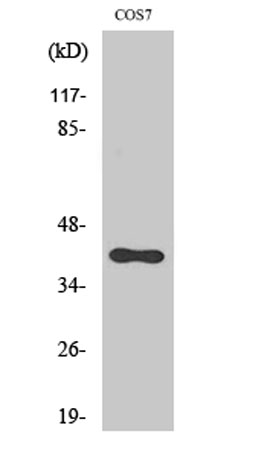
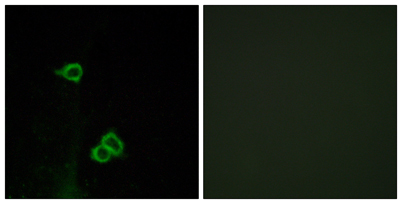
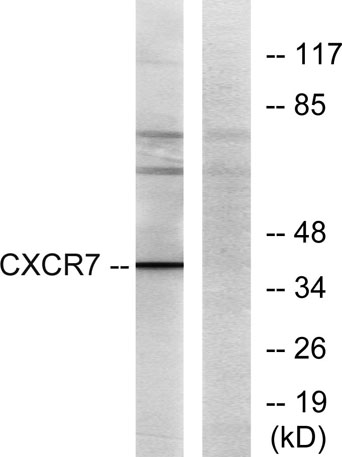
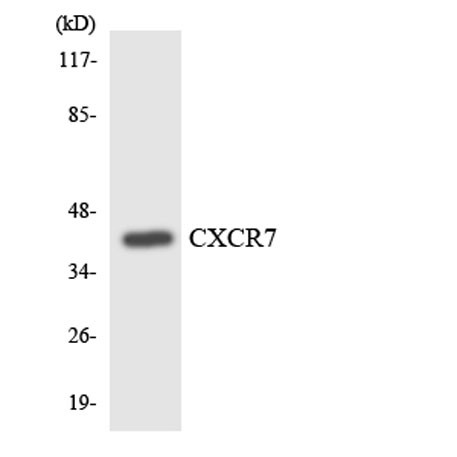
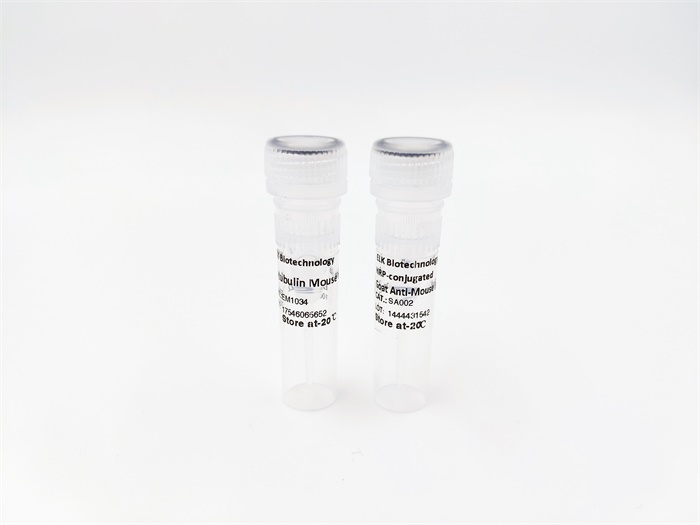



CXCR-7 rabbit pAb
 One-click to copy product information
One-click to copy product information$148.00/50µL $248.00/100µL
| 50 µL | $148.00 |
| 100 µL | $248.00 |
Overview
| Product name: | CXCR-7 rabbit pAb |
| Reactivity: | Human;Mouse;Rat;Monkey |
| Alternative Names: | CXCR7; CMKOR1; GPR159; RDC1; C-X-C chemokine receptor type 7; CXC-R7; CXCR-7; Chemokine orphan receptor 1; G-protein coupled receptor 159; G-protein coupled receptor RDC1 homolog; RDC-1 |
| Source: | Rabbit |
| Dilutions: | Western Blot: 1/500 - 1/2000. Immunofluorescence: 1/200 - 1/1000. ELISA: 1/20000. Not yet tested in other applications. |
| Immunogen: | The antiserum was produced against synthesized peptide derived from human CXCR7. AA range:311-360 |
| Storage: | -20°C/1 year |
| Clonality: | Polyclonal |
| Isotype: | IgG |
| Concentration: | 1 mg/ml |
| Observed Band: | 41kD |
| GeneID: | 57007 |
| Human Swiss-Prot No: | P25106 |
| Cellular localization: | Cell membrane ; Multi-pass membrane protein . Early endosome . Recycling endosome . Predominantly localizes to endocytic vesicles, and upon stimulation by the ligand is internalized via clathrin-coated pits in a beta-arrestin-dependent manner. Once internalized, the ligand dissociates from the receptor, and is targeted to degradation while the receptor is recycled back to the cell membrane. . |
| Background: | This gene encodes a member of the G-protein coupled receptor family. Although this protein was earlier thought to be a receptor for vasoactive intestinal peptide (VIP), it is now considered to be an orphan receptor, in that its endogenous ligand has not been identified. The protein is also a coreceptor for human immunodeficiency viruses (HIV). Translocations involving this gene and HMGA2 on chromosome 12 have been observed in lipomas. [provided by RefSeq, Jul 2008], |
-
 Western Blot analysis of various cells using CXCR-7 Polyclonal Antibody diluted at 1:2000
Western Blot analysis of various cells using CXCR-7 Polyclonal Antibody diluted at 1:2000 -
 Immunofluorescence analysis of COS7 cells, using CXCR7 Antibody. The picture on the right is blocked with the synthesized peptide.
Immunofluorescence analysis of COS7 cells, using CXCR7 Antibody. The picture on the right is blocked with the synthesized peptide. -
 Western blot analysis of lysates from COS7 cells, using CXCR7 Antibody. The lane on the right is blocked with the synthesized peptide.
Western blot analysis of lysates from COS7 cells, using CXCR7 Antibody. The lane on the right is blocked with the synthesized peptide. -
 Western blot analysis of the lysates from RAW264.7cells using CXCR7 antibody.
Western blot analysis of the lysates from RAW264.7cells using CXCR7 antibody.

 Manual
Manual